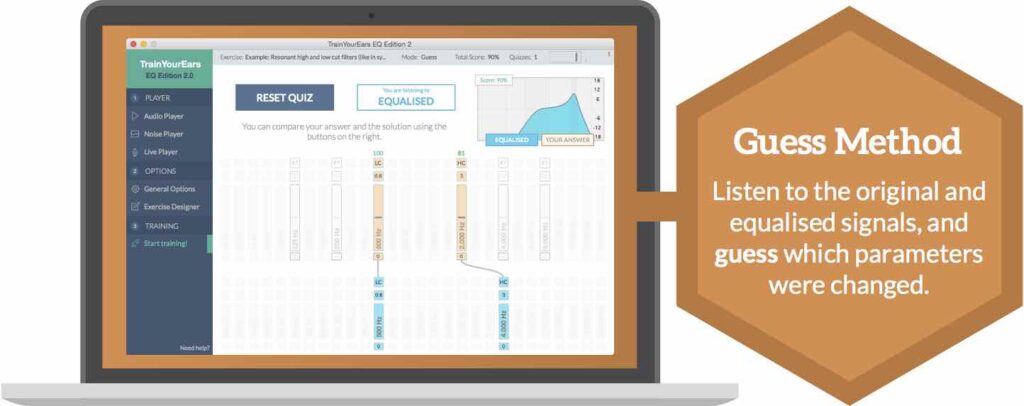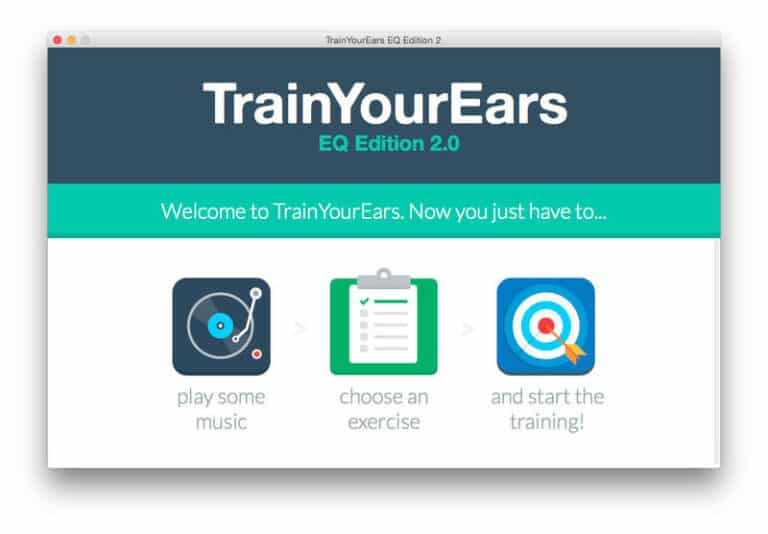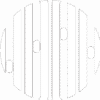Last Updated on February 7, 2022 by IDS Team
What is Train Your Ears?
Train Your Ears is a revolutionary new Music ear training software tool for fine-tuning your ears and mind to the frequencies of different bandwidths, thereby showing you the differences between different sounds at a technical level as well as comparing before and after a bandwidth is changed. A fantastic product for both beginners and seasoned musicians alike, it goes into the granular details of equalisation, bringing a new perspective to a tool all music producers have encountered yet which is so commonplace that it normally becomes an accepted part of production. Train Your Ears is an incomparable way for all musicians to think more deeply about EQ – and in turn about their own music.
Why purchase this music ear training software?
Outside of simply requesting the user to match EQ bands with examples of noise which has been cut or boosted, this music ear training software allows you to move bands around to your liking and experiment with the interface to fine tune your understanding of how it works. In fact, Train Your Ears lets you literally take sound apart and reconstruct it – simply by listening to the different frequencies which resonate within it. So far, no other product comes close to giving the user this amount of freedom to experiment with sound – Train Your Ears is virtually unparalleled in giving musicians a way to EQ which matches their composition process.
When purchasing a DAW, there are many options for an EQ plugin which works for you. We have just recently reviewed probably the best new EQ software right now – Eventide Split EQ, read the review here. However, all of these tend to leave the user alone in terms of working out how to use them. In fact, they presume a pre-existing knowledge of the EQ process. Train Your Ears is therefore totally novel in letting artists combine it with any EQ plugin they wish to show you not just how the technology itself works but how noise itself interacts, creating real effects on the sounds of a song.
How to use the Train Your Ears music ear training software?
Too many articles on the internet attempt to teach EQ and fail because they are explaining a very nuanced concept in words – and yet it is one which is much better shown than told.
Train Your Ears does away with all the unnecessary written details and goes straight into showing you the difference between two versions of the exact same piece of music – one with EQ and one without. A typical practice session has seven bands which correspond to the division of EQ into bandwidths on a typical DAW such as Logic or Ableton.
It is very important for music ear training software products to provide the user with as much interaction as possible.

After a sample is played, it encourages you to match the audio with the corresponding bandwidth change, determining by how much it has been boosted or cut. Checking afterwards will then confirm how accurate your ear is.
The training session will then ask you to change the EQ’d signal so that once again it manages to sound the same as the original, and you are able to check afterwards to see if it is correct. The product also contains a monitor which allows you to see the exact level in decibels by which the signal has been boosted or cut, allowing a precise measurement of the amount of sound.
You can check the price for this product on the Train Your Ears website, by clicking here.
Once you install the product, be sure to check their own documentation and exercises by clicking here.
Personal Review
I personally found that the software easily translated from a digital product to actual, tangible results which I was able to apply to my own music. At first, I was not able to hear the difference between the subtleties of different bandwidths and the smaller, technical divisions music falls into such as bass and sub-bass, but with even a small amount of time spent listening to Train Your Ears, I found myself becoming more finely attuned, simply because I had reference points.
By allowing the usage of songs which are already familiar, the music ear training software product manages to hold attention and makes the process of getting deep into some of the most subtle and technical aspects of music much easier. It translates terminology which is understandable first and foremost to those who are intimately familiar with the equipment into something manageable for most if not all musicians to turn into a fantastic reference for their own production skills.
It could be assumed that the applicability of this technology heavily depends on the style of music you are producing. Some genres, such as heavy metal, have very specific, niche methods of production which do not necessarily align to the customary methods of EQ’ing. Therefore, for those working in these genres, one key point for Train Your Ears would be if it is adaptable to managing other methods of working. Personally, I found the interface had a beautiful cleanliness and simplicity – which means it is flexible enough that in the hands of someone familiar with their genre, it can be adapted to suit any kind of music.
Pointing out the different bandwidths numerologically also means that there is a tangible, logical, concrete result for any EQ changes. EQ changes are not just an abstract wall of sound – instead they are given as precise numerical data so you can see exactly which bandwidth has been changed and where – as well as keeping track of multiple boosts and cuts.
You can check the price for this product on the Train Your Ears website, by clicking here.
Conclusion
In conclusion, Train Your Ears is an indispensable way to get more in depth and understand the full picture of how EQ works before applying it to your own music. Any musician can benefit from it – whether novices or pros, it shows the real vibrations and elements which make up any production. Not only this, it does this in the abstract whilst also directly linking the sound you hear to measurable values.
In this way, it is a really valuable piece of kit – and most importantly gives you a way to change in real time an equalised piece of music to make it match the original again – demonstrating how much EQ’ing can change the sound of a song but also how, with the right skills, it is possible to manipulate it at multiple levels to reach a broader and more nuanced picture of your production, therefore giving the artist more freedom.



